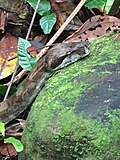This is an old revision of this page, as edited by Wormsoft98 (talk | contribs) at 07:24, 16 January 2023 (Added image of Boa nebulosa to species table and iNaturalist link for additional info). The present address (URL) is a permanent link to this revision, which may differ significantly from the current revision.
Revision as of 07:24, 16 January 2023 by Wormsoft98 (talk | contribs) (Added image of Boa nebulosa to species table and iNaturalist link for additional info)(diff) ← Previous revision | Latest revision (diff) | Newer revision → (diff) Genus of snakes
| Boa | |
|---|---|

| |
| Boa constrictor, B. constrictor | |
| Scientific classification | |
| Domain: | Eukaryota |
| Kingdom: | Animalia |
| Phylum: | Chordata |
| Class: | Reptilia |
| Order: | Squamata |
| Suborder: | Serpentes |
| Family: | Boidae |
| Subfamily: | Boinae |
| Genus: | Boa Linnaeus, 1758 |
| Type species | |
| Boa constrictor svg | |
Boa is a genus of non-venomous boas found in Mexico, the Caribbean, and Central and South America. Five species are currently recognized.
Etymology
The Online Etymology Dictionary says that the word comes from the "late 14c., "large snake," from Latin boa, type of large serpent mentioned in Pliny's "Natural History;" origin unknown (in medieval folk etymology the name was associated with Greek bous "ox")."
Species
Boa is a polytypic genus and so contains more than one species.
| Image | Scientific Name | Common Name | Distribution |
|---|---|---|---|
 |
Boa constrictor | Boa constrictor | South America |
 |
Boa imperator | Central American boa | Mexico, Central America and South America |
 |
Boa nebulosa | Dominican boa | Dominica. |
 |
Boa orophias | St. Lucia boa | Saint Lucia. |
 |
Boa sigma | Mexican west coast boa constrictor | Mexico |
The boa constrictor has been reported to grow to a maximum of 14 feet (4.3 m) in length. Numerous subspecies are currently recognised. A now extinct species, the Marie-Galante boa (Boa blanchardensis), lived during the Pleistocene on Marie Galante in the Lesser Antilles.
Distribution and habitat
Boa species are found in northern Mexico through Central America (Belize, Guatemala, Honduras, El Salvador, Nicaragua, Costa Rica and Panama) to South America north of 35°S (Colombia, Ecuador, Peru, Venezuela, Guyana, Suriname, French Guiana, Brazil, Bolivia, Uruguay and Argentina). One species is present in the Lesser Antilles (Dominica and St. Lucia), on San Andrés, Providencia and many other islands along the Caribbean coasts of Mexico and Central and South America.
Taxonomy
Kluge (1991) moved the genera Sanzinia and Acrantophis into Boa, based on a phylogeny derived from morphological characters. However, it has since been shown that the Malagasy boids and Boa constrictor do not form a monophyletic group, and the lumping of Sanzinia, Acrantophis and Boa was, therefore, an error. These snakes are therefore correctly represented in their own genera: Sanzinia and Acrantophis.
To add further to the naming confusion, many species of snake in the family Boidae are known colloquially as "boas". Also, more than a few subspecies of B. constrictor are recognized, several of which have distinct common names.
References
- Boa at the Reptarium.cz Reptile Database. Accessed 28 March 2022.
- "boa | Origin and meaning of boa by Online Etymology Dictionary". www.etymonline.com. Retrieved 2019-09-04.
- Daltry, J.C.; Powell, R.; Henderson, R.W. (2018). "Boa nebulosa". IUCN Red List of Threatened Species. 2018: e.T74863215A75171341. doi:10.2305/IUCN.UK.2018-2.RLTS.T74863215A75171341.en. Retrieved 18 November 2021.
- Daltry, J.C. (2018). "Boa orophias". IUCN Red List of Threatened Species. 2018: e.T74866530A75171346. doi:10.2305/IUCN.UK.2018-2.RLTS.T74866530A75171346.en. Retrieved 18 November 2021.
- Mehrtens JM. 1987. Living Snakes of the World in Color. New York: Sterling Publishers. 480 pp. ISBN 0-8069-6460-X.
- McDiarmid RW, Campbell JA, Touré T. 1999. Snake Species of the World: A Taxonomic and Geographic Reference, vol. 1. Herpetologists' League. 511 pp. ISBN 1-893777-00-6 (series). ISBN 1-893777-01-4 (volume).
- Kluge AG. 1991. Boine Snake Phylogeny and Research Cycles. Misc. Pub. Museum of Zoology, Univ. of Michigan No. 178. 58 pp.
- ^ Noonan, Brice; Chippindale, P. (2006). "Dispersal and vicariance: The complex evolutionary history of boid snakes". Molecular Phylogenetics and Evolution. 40 (2): 347–358. doi:10.1016/j.ympev.2006.03.010. PMID 16624591.
- Vences, Miguel; Glaw, F.; Kosuch, J.; Boehme, W.; Veith, M. (2001). "Phylogeny of South American and Malagasy boine snakes: Molecular evidence for the validity of Sanzinia and Acrantophis and biogeographic implications". Copeia. 2001 (4): 1151–1154. doi:10.1643/0045-8511(2001)001[1151:posaam]2.0.co;2.
- Reynolds, R.G.; Niemiller, M.L.; Revell, L.J. (2014). "Toward a Tree-of-Life for the boas and pythons: Multilocus species-level phylogeny with unprecedented taxon sampling". Molecular Phylogenetics and Evolution. 71: 201–213. doi:10.1016/j.ympev.2013.11.011. PMID 24315866.
Further reading
- Kluge AG. 1991. Boine Snake Phylogeny and Research Cycles. Misc. Pub. Museum of Zoology, Univ. of Michigan No. 178. 58 pp. PDF at University of Michigan Library. Accessed 11 July 2008.
- Vences M, Glaw F, Kosuch J, Böhme W, Veith M. 2001. Phylogeny of South American and Malagasy Boine Snakes: Molecular Evidence for the Validity of Sanzinia and Acrantophis and Biogeographic Implications. Copeia No 4. p. 1151-1154. PDF at Miguel Vences. Accessed 29 August 2008.
- Vences M, Glaw F. 2003. Phylogeography, systematics and conservation status of boid snakes from Madagascar (Sanzinia and Acrantophis). Salamandra, Reinbach, 39(3/4): p. 181-206. PDF at Miguel Vences. Accessed 29 August 2008.
External links
- Boa at the Reptarium.cz Reptile Database. Accessed 5 July 2008.
- Acrantophis at the Reptarium.cz Reptile Database. Accessed 10 July 2008.
- Sanzinia at the Reptarium.cz Reptile Database. Accessed 10 July 2008.
- iNaturalist page
| Taxon identifiers | |
|---|---|
| Boa | |